Surface 3 review: Finally, a cheap Surface you'd actually want

Once again, the third time's the charm for Microsoft's Surface lineup -- for the most part. Last year's Surface Pro 3 was the software giant's most compelling implementation yet of its hybrid laptop/tablet concept. Now we have the Surface 3, the third entry in its cheaper Surface lineup. And while it may look similar to its predecessors, it's actually a completely different beast. It's a $499 Surface tablet that can actually run all of the Windows programs you're used to, not just Windows 8 apps. And to Windows RT, the stripped down version of Microsoft's OS that previously powered the non-Pro Surface tablets, all I have to say is: So long, goodbye. Don't let the door hit you on the way out! By giving up on Windows RT, Microsoft has finally managed to make a decent cheap Surface.
Hardware
No, there aren't any major surprises when it comes to the Surface 3's hardware. It has the same silver magnesium alloy case with smooth chamfered edges, which gives it a smooth, premium feel in your hands. And of course, there's the iconic kickstand, which can now click into three positions, one step beyond the Surface 2. It's not nearly as versatile as the Surface Pro 3's fully customizable kickstand (which has no distinct positions), but it's enough to make the Surface 3 fit comfortably on your lap in many different orientations. This time around there's also support for Microsoft's pressure-sensitive stylus, something that's always been available on the Surface Pro series, but never the plain Surface line.
Don't take my lack of surprise as a negative, though -- the Surface 3 is still incredibly well-designed, with an attention to detail you don't find on most laptops and tablets. Even today, after testing all five previous Surface devices over the past few years, I'm still impressed with Microsoft's craftsmanship. Now that it's finally running software you'd actually want to use, the Surface 3 might make more people recognize Microsoft's design chops.
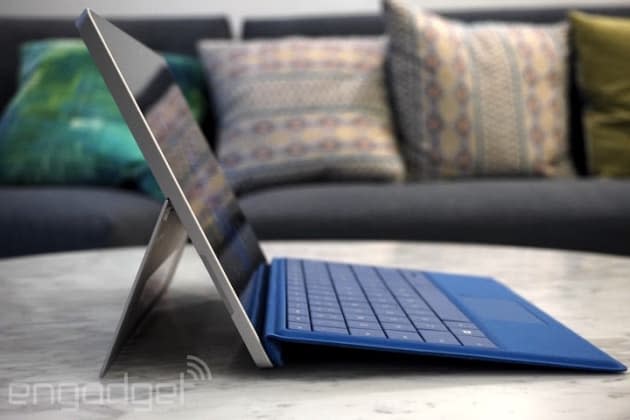
On a purely hardware level, the Surface 3 is the fullest realization of Microsoft's original Surface dream: a portable tablet that can do double-duty as a laptop. It features a new Intel Atom x7 processor, which lets it run traditional Windows apps, unlike the previous Tegra 4 chip. At 1.37 pounds and 0.34 inch thick, the Surface 3 is also a tad lighter and thinner than the Surface 2, which clocked in at 1.49 pounds and 0.35 inch thick. The two tablets still feel very different, though. The Surface 3 adopts the 3:2 screen aspect ratio from the Surface Pro 3 for its 10.8-inch screen, which makes it resemble a sheet of paper more than the wide 16:9 displays on previous Surfaces. And while that means the Surface 3 will show black bars when watching movies, the new proportions make it far more balanced to hold as a tablet. The previous Surface's wide screen just felt more awkward when held in one hand -- especially in portrait mode.
The Surface 3 might make more people recognize Microsoft's design chops.
Compared to the 1.76-pound Surface Pro 3, the Surface 3 is noticeably lighter and better-suited to being used as a tablet. But the Pro model makes for a much better ultraportable laptop, given its vastly superior hardware. That's to be expected, but it's a reminder that anyone considering the Surface 3 needs to think hard about how, exactly, they plan to use it.

Alongside the Surface 3's edges, you've got a full-sized USB 3.0 port, Mini DisplayPort, headphone jack and a micro-USB port for charging (no more proprietary cables!). And of course, there's the usual power button and volume rocker, as well as a microSD card slot underneath the kickstand (something Microsoft's included in past models). Again, there aren't many surprises, but I grew to appreciate the Surface 3's ability to charge over micro-USB. While it comes with a USB power adapter, you can also plug the Surface 3 into just about any micro-USB charger (or even another device with a USB port). Unless you trek out into the middle of nowhere, there's little chance you'd find yourself stranded without the ability to juice up the Surface 3.
If you're the type who enjoys taking photos with your tablets -- something I'll never understand -- you'll be pleased to know the Surface 3 also sports a new 8-megapixel rear camera. That's a step up from the 5MP shooter on the Surface 2, which we found to be fairly disappointing in our review. There's also a 3.5MP front-facing camera, which should be far more useful.
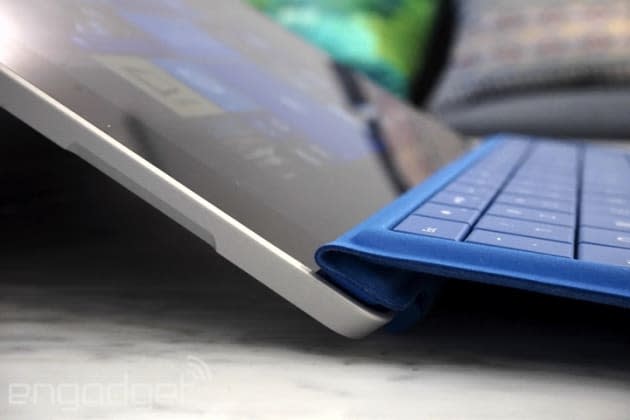
Once again, you'll have to buy one of Microsoft's $130 Type Covers separately if you actually want a keyboard. And, let's face it, there's no reason why you'd want to buy the Surface without the Type Cover. Since the beginning, Microsoft's positioned its unique keyboards as expensive accessories -- because the Surface is, after all, a tablet. The problem with that logic, though, is that Microsoft also wants it to be seen as a laptop replacement. And trying to sell a laptop without a keyboard is like trying to sell a car without a steering wheel (no, Google's self-driving cars don't count). It's just not going to happen. Microsoft is so eager to compete with the iPad's price that it's practically lying to consumers about the Surface's true cost. That may have been excusable at the start -- maybe -- but at this point it just feels gross.
Trying to sell a laptop without a keyboard is like trying to sell a car without a steering wheel.
Just like before, the Surface 3's Type Covers latch onto the tablet with a strong magnetic clip. But, taking another cue from its bigger brother, it also angles up slightly, which makes it more stable while on your lap. Microsoft has created a new Type Cover to fit the Surface 3's smaller frame, but you can also attach any of the previous Surface keyboard cases if you've got them lying around (though they will hang over the tablet's edges a bit). There's no new Touch Cover (which doesn't have physical keys) for the Surface 3, which may be a sign Microsoft is ready to give up on that whole concept. But given just how thin and capable it's been able to make the Type Cover, I don't expect anyone will mourn the inevitable death of the Touch Cover.
Even though the Surface 3's Type Cover is smaller than the Pro version, I found it easy to type on, with a decent amount of feedback from the keys. It's slightly more difficult to balance on your lap when it's connected to the Surface 3, but it was still comfortable enough for me to type up most of this review.
Display and pen input
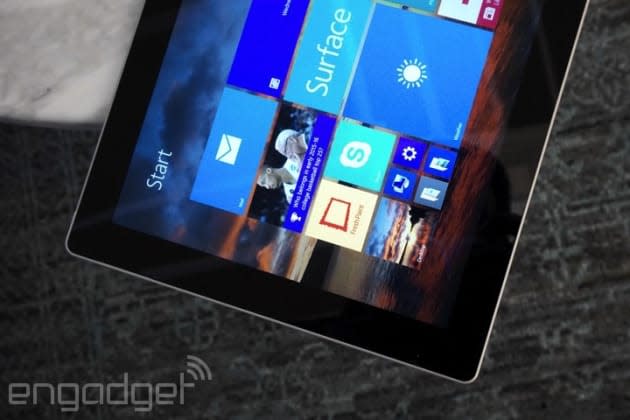
Microsoft managed to cram some nice displays into the last round of Surface devices, and that trend continues with the Surface 3. It features a 10.8-inch LCD with a 1,920 x 1,280 resolution that's bright, crisp and colorful. It's not as sharp as the iPad Air 2's Retina screen, or the Quad HD screens in Samsung's Galaxy Tab S line, but it's a fine display for extended reading, photo viewing and even watching movies (I particularly enjoyed using the Surface 3 to catch up on my Comixology queue). But if you have issues reading small text, take note: The Surface 3's generous resolution will make some websites and programs hard to use. Be prepared to bump up the text size in your system settings and browser.
As is usually the case with LCDs, the Surface 3's display fares well indoors, but loses its luster outdoors. It's still usable -- you can easily make out text and photos -- but you'll have to get through plenty of reflectivity to get anything done. It's hard to fault the Surface too much when this is a problem you'll face with most tablets and laptops, even those significantly more expensive. For what it's worth, the Surface Pro 3 performs much better in direct sunlight.
It makes a strong case for including pressure-sensitive stylus support in more tablets.
For the artistic crowd, adding support for the Surface Pen is a wise move. It's the same stylus that's included with the Surface Pro 3, and it relies on that device's N-trig digitizer. Unfortunately, Surface 3 users have to shell out an additional $50 to get it, but since it's a fairly niche product, it makes sense for Microsoft to keep it separate. After pairing it over Bluetooth, you can click the top button of the Surface Pen to open up a new OneNote file and start scribbling your thoughts. Click it again, and it gets sent to your OneDrive cloud storage. And just as with the Surface Pro 3, you can even wake up the computer from sleep by clicking the Pen's top button, which brings you right to a blank OneNote page.
When it comes to putting the Pen to the screen, the Surface 3 feels about as good as its Pro sibling. That is to say, it's a pretty smooth experience. There wasn't much lag between hitting the screen and getting something to show up, and there's a decent amount of paper-like resistance against the screen. It certainly won't make you forget you're drawing on glass, but it makes a strong case for including pressure-sensitive stylus support in more tablets.
The biggest problem with the Surface Pen? There's no place to hold it on the Surface 3. The Type Cover for the Surface Pro 3 at least gives you a slot to tuck the Pen away.
Performance and battery life
PCMark7 | 3DMark06 | 3DMark11 | ATTO (top disk speeds) | |
|---|---|---|---|---|
Microsoft Surface 3 (1.6GHz Atom x7-Z8700, Intel HD Graphics) | 2,839 | 3,920 | E941 / P552 | 163 MB/s (reads); 39.2 MB/s (writes) |
Microsoft Surface Pro 3 (1.9GHz Core i5-4300U, Intel HD 4400) | 5,024 | 5,053 | E1,313 / P984 | 555 MB/s (reads); 252 MB/s (writes) |
HP Spectre x360 (2015, 2.2GHz Intel Core i5-5200U, Intel HD 5500) | 4,965 | 8,810 | E1,667 / P932 / X265 | 555 MB/s (reads); 270 MB/s (writes) |
Microsoft Surface Pro 2 (1.6GHz Core i5-4200U, Intel HD 4400) | 4,922 | 6,236 | E1,906 / P997 / X303 | 534 MB/s (reads); 167 MB/s (writes) |
HP Spectre 13 Ultrabook (1.6GHz Core i5-4200U, Intel HD 4400) | 4,786 | 6,005 | E1,837 / P962 / X293 | 527 MB/s (reads); 327 MB/s (writes) |
Lenovo Yoga 3 Pro (1.1GHz Intel M-5Y70, Intel HD 5300) | 4,699 | 4,734 | E1,076 / P595 / X175 | 554 MB/s (reads); 261 MB/s (writes) |
HP Stream 11 (2.16Ghz Intel Celeron N2840, Intel HD) | 2,607 | N/A | E374 | 168 MB/s (reads); 72 MB/s (writes) |
When you see the "Intel Atom" label, it's hard not to conjure up memories of netbooks, those tiny Atom-powered laptops that preceded the iPad and other modern tablets. They were perpetually underpowered, but their diminutive size and cheap price made them ideal for being secondary portable computers. So I was surprised at just how capable the quad-core Atom x7-Z8700 chip in the Surface 3 is. It runs at 1.6GHz, but it can bump up to 2.4GHz in bursts. The Atom x7, which was announced at Mobile World Congress, also balances that speed with intelligent power management. Because of that, the Surface 3 doesn't even need a fan to stay cool.
Overall, the Atom x7 feels like a step up from the previous generation of Atom processors we see in Chromebooks. I was able to run Firefox and Chrome, both with multiple windows and plenty of tabs, along with Spotify and Skype without any significant slowdown. Launching new apps felt speedy, and I didn't have any issues moving between the apps and swiping around Windows 8's interface. The only thing I had to keep an eye on was complex web apps like TweetDeck eating up too much RAM in Chrome -- but that's something I also have to deal with on my desktop and MacBook Air. And as you can tell from the benchmarks above, the Surface 3's disk speeds can't compare to more powerful laptops, so it won't be much of a media-creation machine.
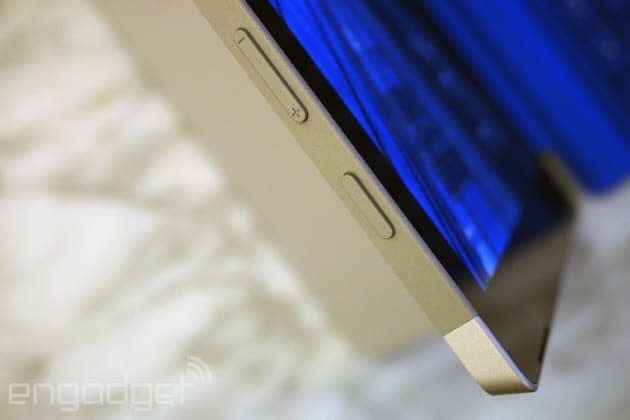
Mostly, I enjoyed the fact that I could use the Surface 3 like a normal Windows computer. I wasn't restricted to Windows 8 apps and pre-installed Office apps like the Surface 2 and Surface RT, and that goes a long way toward making it more useful. I missed simple things on the Surface 2, like the speediness of Chrome, my library of Steam games and editing photos quickly with Paint.Net. As a tablet, the Surface 3 was easy to hold as I caught up on Saga with the Windows 8 Comixology app. Microsoft's OS still holds back it's true tablet potential, though -- there still aren't many great Windows tablet apps, and using the Surface in tablet mode on the desktop is as awkward as ever.
The Surface 3 has its limits, of course -- 4K YouTube streams were a stuttery mess, and it's not nearly powerful enough to run graphics-hungry games. But that's no surprise since it's toting an Atom chip. And since the Surface 3's screen tops out at just above 1080p, you won't be viewing 4K files on it anyway. Gone Home, a first-person indie game that doesn't need much horsepower, loaded up quickly, but it was only playable at a 720p resolution. And even then, it was still kind of choppy.
4K YouTube streams were a stuttery mess, and it's not nearly powerful enough to run graphics-hungry games.
My experience with the Surface 3 might be much different than yours, though. Microsoft sent me the $599 model with 4GB of RAM -- the bare minimum you'd want in any computer these days -- and 128GB of storage. The entry-level $499 Surface 3 only has 2GB of RAM, which means it'll be far less capable when it comes to juggling multiple apps. Given just how cheap RAM is these days, you'd think Microsoft would just bite the bullet and include more memory by default. The Surface 2 performed decently with only 2GB of RAM, though, but that machine couldn't run traditional memory-hungry Windows software.
On the storage front, the Surface 3 is a significant upgrade over its predecessor, which only offered 32GB and 64GB options. The Surface 3's 64GB and 128GB options are far more palatable for an actual computer -- you'll have room for a slew of programs, as well as music and video files.
Tablet | Battery Life |
|---|---|
Microsoft Surface 3 | 9:11 |
Microsoft Surface 2 | 14:22 |
iPad Mini 3 | 13:45 |
Dell Venue 8 7000 series | 12:11 |
HP Spectre x360 | 11:34 |
iPad Air 2 | 11:15 |
Microsoft Surface RT | 9:36 |
Nexus 9 | 9:10 |
Samsung Galaxy Tab 2 10.1 | 8:56 |
Sony Xperia Tablet Z | 8:40 |
HP Stream | 8:17 |
Lenovo Yoga 3 Pro | 7:36 |
HP Slate 7 | 7:36 |
Microsoft Surface Pro 3 | 7:08 |
Samsung Chromebook 2 (11-inch) | 7:00 |
HP SlateBook x2 | 6:34 (tablet only) / 8:49 (keyboard dock) |
Microsoft claims you'll get around 10 hours of battery on the Surface 3, which is more than the nine hours and 11 minutes I saw in our standard battery test (looping an HD video at 65 percent brightness until it loses power). That's a big step down from the Surface 2, which lasted a whopping 14 hours and 22 minutes in our tests. Still, it was able to keep up with me for most of a workday, starting at 9 AM and finally losing charge around 4 PM.
Configuration options and the competition
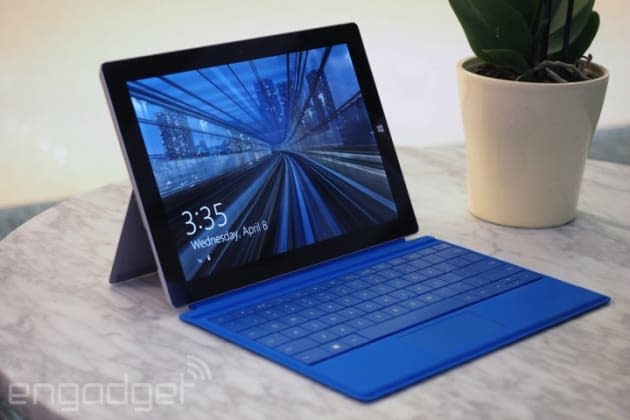
On top of the 64GB $499 and 128GB $599 options, there are also LTE-equipped Surface 3 models on the horizon starting at $599 with 64GB of storage. But don't forget, you've also got to add the $130 Type Cover if you want a keyboard and another $50 for the stylus. That puts the entry level Surface 3 at $680 with all of its accessories. And, for the first time, there's also a $200 docking station for the low-end Surface, which includes four USB ports, a Mini DisplayPort, and Gigabit Ethernet.
Sure, the Surface 3 could be seen as an iPad Air 2 competitor. They start at the same price (sans the Type Cover), and they're both aiming at the 10-inch tablet market. But you could just as easily see it as a more functional alternative to mid-range Chromebooks like Samsung's $400 Chromebook 2, which can only run apps within Google's Chrome browser. It's also a more powerful option than cheap Windows laptops like HP's $200 Stream, which are the centerpiece of Microsoft's plan to take on Chromebooks. And, of course, the Surface 3 is basically just a stripped-down version of the Surface Pro 3, which starts at $799 without a Type Cover (though you'd likely end up spending around $1,000 if you bump up the specs).
As I mentioned above, you should think hard about how you're going to use the Surface 3 before committing. If you just want a cheap web-browsing computer, go for a Chromebook instead. If you're mainly concerned about getting the best tablet experience, get the iPad Air 2. And if the Surface 3 sounds underpowered, consider saving up for the Surface Pro 3 (or its eventual successor, which could land in the next few months).
Wrap-up
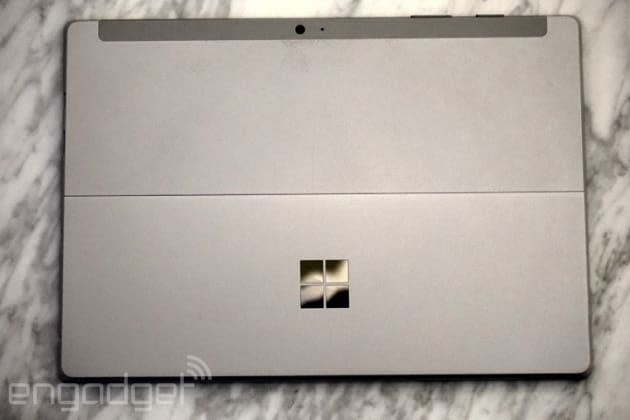
I can't recommend the Surface 3 to everyone, but it's the first $499 Surface that I can recommend to someone. And that's more than I can say for the Surface 2 and RT. It's a machine that's capable of doing a lot -- within limits. And come the eventual Windows 10 upgrade, which will be freely available to all Windows 7 and 8 users later this year, it will only get better.
I can't recommend the Surface 3 to everyone, but it's the first $499 Surface that I can recommend to someone.
Even if it's not for you, the Surface 3 shows that Microsoft's vision of a single device that can serve as both tablet and laptop isn't a mere pipe dream. The company is learning from its mistakes -- ahem, Windows RT -- and it's continually doubling down on what makes the Surface lineup great. The big problem for Microsoft? It still doesn't have a killer, must-buy Surface. And that leaves it open to being usurped.













































